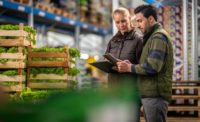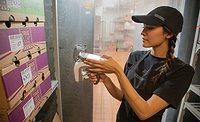Item-level Traceability Technology Is Transforming Food Safety and Quality

Item-level traceability starts at the farm and gives everyone in the supply chain an added level of protection—the knowledge to know where a food safety problem began, and how many products are affected. Image courtesy of Mojix
The food industry landscape is changing. Recent supply chain instability, technology advancements and customer safety requirements have evolved in recent years. Supply chain professionals need a way to keep up.
Fortunately, advanced food-industry technologies provide the solutions food processors, suppliers, restaurants and consumers need to stay on top of food safety. Item-level traceability is transforming the food and restaurant industry with precise, efficient solutions that inform everyone along the journey, from producer to consumer.
With significant regulatory implementations like the FDA Food Safety Modernization Act (FSMA) 204, track and trace technology is in prominent demand.
Three things steady the pulse of every restaurant and food industry operation: food safety, compliance and reputation. To maximize all three, cutting-edge technology must be adopted at a large scale.
Traditional Food Safety Concerns in the Supply Chain
Throughout history, restaurants and producers have faced a consistent challenge: ensuring the safety and quality of food. Safety risks arise primarily due to insufficient monitoring, tracking and handling of consumable products.
With so many moving parts, tracking foodborne illness sources and contamination incidents has not been straightforward. Until the emergence of supply chain technology, companies have had to keep records manually, which made locating and mitigating recalls a logistical nightmare.
To address this cumbersome limitation, food companies are reaching for item-level visibility technology to effectively trace their products’ every step in the supply chain. The result? Mitigated insufficiencies, minimized health and safety risks, and decreased food waste.
Industry Demands for Item-level Traceability Technology
Today, technology makes it possible for grocery store patrons to use their smartphones and check the entire route a food product has taken on its way from the farm to the market. Similarly, consumers who enjoy going to restaurants assume that the food they consume is safe, and that the eateries know where their food originates and has traveled before being prepared for a meal. Item-level traceability solutions provide restaurants with real-time visibility of every movement throughout their supply chain. Advanced tools like RFID (radio-frequency identification), IoT (internet of things) sensors, blockchain, and serialized barcodes track individual and bulk items.
From first origin to customers’ hands, restaurants gain access to important data for actionable outcomes. Early detection, product traceability, predictive insights and recall management are several key solutions of item-level traceability technology—more benefits follow:
Ensure food safety—Every year, more than 48 million people in the U.S. alone experience food-related illnesses. Many of these can be prevented with early detection across food suppliers. Real-time item-level visibility (RTILV) can identify the source, monitor potential spread and enable swift recall before more consumers become affected.
Increase quality control—Restaurants that track the origin of safety and health incidents experience better control over ingredients. Every detail from harvest to handling to storage is accessible with RTILV technology, equipping companies to vet which ingredients to use or discard, promising high-quality, safe dishes. Additionally, businesses protect themselves from legal issues.
Facilitate consumer transparency and trust—Consumers increasingly value transparency about the products and ingredients they consume, opting to buy from companies they can trust. Item-level traceability equips restaurants and food suppliers to accurately disclose where their ingredients are from, how products were sourced, what production methods were used and how fresh each item is. If information is power and transparency is key, providing both unlocks a new level of customer trust.
Enable effective recall management—While item-level traceability mitigates recalls, it also simplifies the process when a recall might occur. Easy identification of affected products reduces the magnitude of recalls, minimizing food waste and stopping affected items before they reach their vendor. Effective recall management hence minimizes financial loss, protecting a company’s bottom line.
Optimize the supply chain process —Accurate traceability solutions encourage optimal supply chain movement and handling, helping restaurants manage their operations more efficiently. It’s all about reducing costly mistakes, preventing food waste and cutting transportation costs across the supply chain.
Comply with FDA FSMA regulations—FSMA 204 was set in place in September 2020 to establish improvements in tracking and tracing high-risk food products. As a result, regulations now require food facilities to maintain precise records and product tracing. Item-level traceability technology enables facilities to remain compliant with ease and provide critical tracking events when food safety issues arise.
Large food chains are transitioning to RFID and item-level traceability technology to secure customer safety and company success. The $66 billion chain Chipotle has adopted RFID real-time technology to improve its food safety and quality control across 3,200 locations. Mojix has helped Chipotle create true end-to-end supply chain visibility that drives inventory and replenishment optimization.

Item-level traceability lets supply chain participants, groceries and restaurants home in on products that may have a food safety problem—without having to recall a zillion tons of perfectly good food. Image courtesy of Mojix
When Chipotle Puts Item-Level Traceability and RFID to Work, Suppliers Benefit
Suppliers have invested in RFID technology using Chipotle specifications, which is anticipated to save suppliers time on inventory management and stock rotation, mitigate human error and increase expiration date visibility and accountability. Initially, Chipotle invited key supply partners to participate in the early tests and provided partners with an RFID playbook with best practices and benefits of the program. Chipotle has created a very collaborative relationship with its suppliers in the roll out and on-going use of the technology.
Chipotle is one of the first large restaurant companies to test RFID technology for optimizing operations and tracing ingredients at select restaurants, enabling real-time, item-level visibility for food safety, ensuring accurate item-level traceability and tracking of ingredients from source to table.
“RFID labels transform inventory management into an automatic, digital function that optimizes restaurant operations and gives our Restaurant Support Centers access to inventory data in real time,” says Scott Boatwright, chief operating officer, Chipotle. “This integrated technology is improving our employee experience in participating restaurants while also benefiting our supply partners.”
Traceability technology is enabling Chipotle to provide further transparency into the direct source of its ingredients, including dairy and avocados from five Chipotle suppliers. Ingredients arrive at Chipotle restaurants affixed with RFID enabled case labels and are scanned by RFID readers, which complement existing scanners in the restaurants, requiring minimal incremental investment. The tech-enabled traceability system is designed to allow the company to act on food safety and quality concerns swiftly, efficiently and precisely.

Barcodes can be used for item-level traceability. Image courtesy of Mojix
Real-Time Item-Level Visibility: Track and Trace Through the Food Supply Chain
From fresh, local ingredients to high-quality global imports, item-level traceability is making the food supply chain safer than ever before.
With accurate, efficient safety and quality management protocols in place, brands not only gain the consumer trust they deserve—they reap massive benefits and protections through their entire supply chain. All thanks to RTILV technology.
The future of food is here. To mitigate risk, ensure compliance, and solidify customer loyalty throughout your company, embrace item-level traceability solutions today.
Looking for a reprint of this article?
From high-res PDFs to custom plaques, order your copy today!








